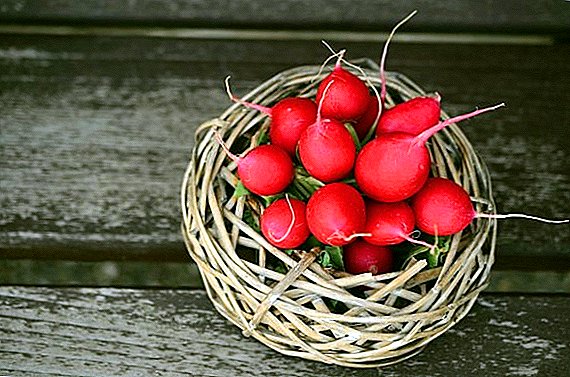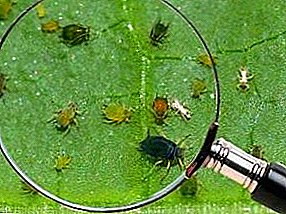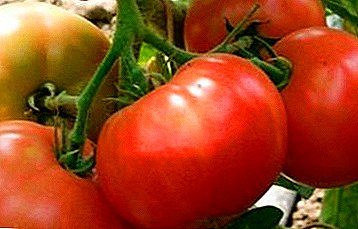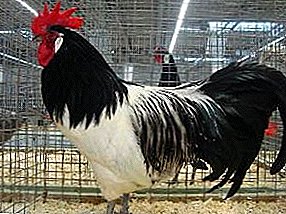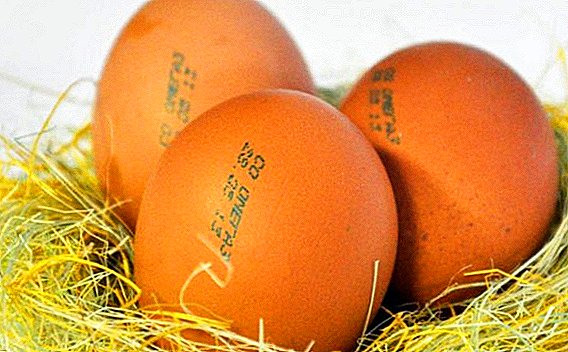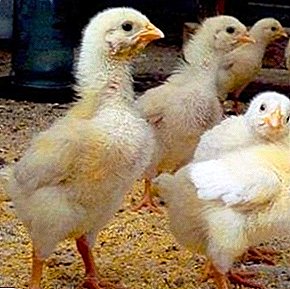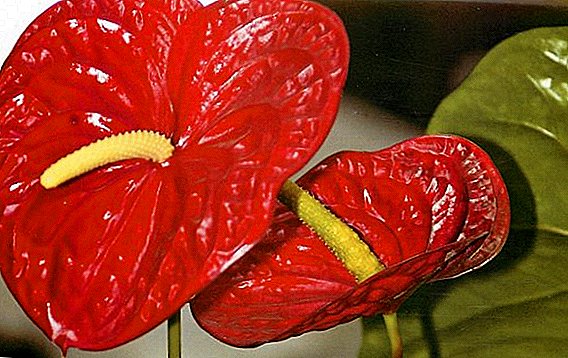 Juicy greens and bright red bracts make Anthurium Andre a very ornamental plant. Anthurium bracts, often mistakenly called flowers, can be colored red, orange or white.
Juicy greens and bright red bracts make Anthurium Andre a very ornamental plant. Anthurium bracts, often mistakenly called flowers, can be colored red, orange or white.
In this article we will explain how to grow this plant at ordinary room temperature for many years and even successfully propagate it.
Botanical description of the plant
Anthurium andreanum is an evergreen herb, belonging to the Aronnik family and to a genus with more than 600 species. The flower consists of an inflorescence in the form of a yellow cob and a perianth. The inflorescence is collected from a variety of small flowers, the color of the perianth may be different.
Anthurium is grown in pot culture due to the beautiful leaves and perianth heart-shaped. Bracts, depending on the species of anthurium, are snow-white, burgundy, pink, cream or green.
Sorta
Over the wild form of anthurium Andre repeatedly worked breeders, seeking new unusual and bright colors of bracts. As a result of breeding new varieties of hybrids appeared:
- Leganza. Characterized by an unusual color of the bract bracts - with a smooth transition from pink to pale green color. The bract is bordered with a yellow cone of inflorescence. A leaf in the form of a rounded peak with a sharp tip. The hybrid has a volume bush.
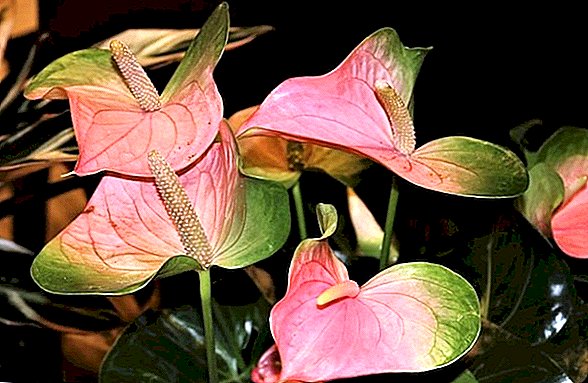
- Champion. The leaves are large, glossy, shiny, have a bright green color. There are two varieties of this hybrid with a different perianth color: Pink - with a pink color, White - with a cream.
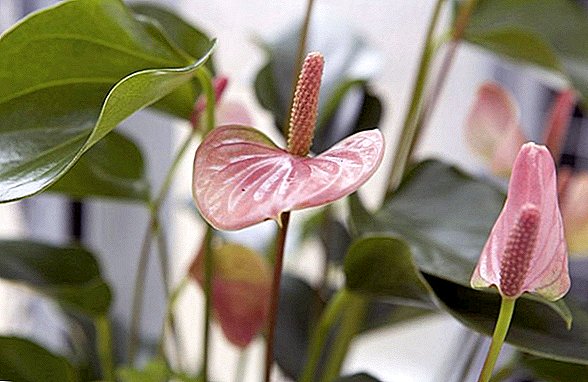
- Ed. It has bright maroon coverlets of bracts and large round dark green leaves. Bract color may be brighter or paler, depending on growing conditions.

- Mix These are hybrids, in which the color of the coverlet has various colors, and the leaves are of the usual oval shape.

- Otazu Hybrid with dark red bract, yellow center and fleshy, green, rounded leaves with pointed edges.
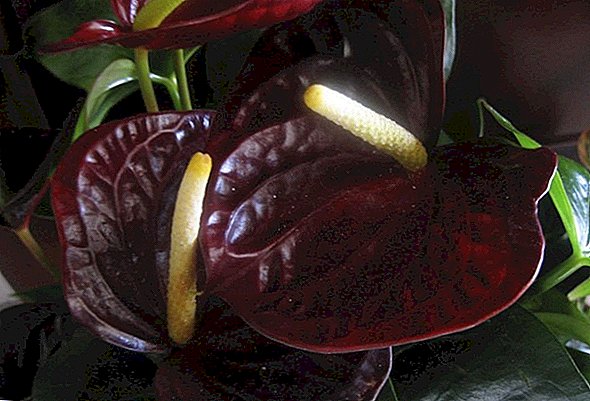
- Silence. It has a delicate pale pink or cream-colored bedspreads and light green leaves. Being in weak light, the bush changes the color of the leaves to a darker one.
- Belize The cover of the bract is purple-red, sometimes having a green strip along the edge. The inflorescence has a traditional yellow color.
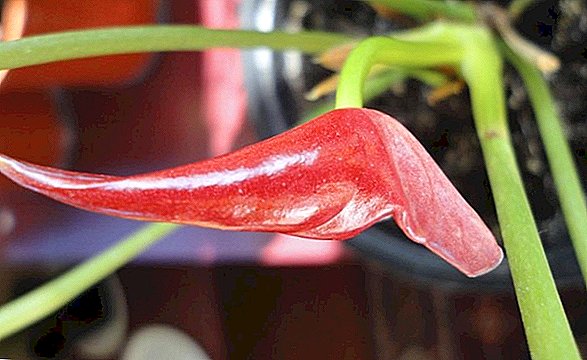
- Favorite. Hybrid with a high bush - the stems reach 1 meter. The color of the bracts varies from salmon to bright pink. Inflorescence is colored in purple.
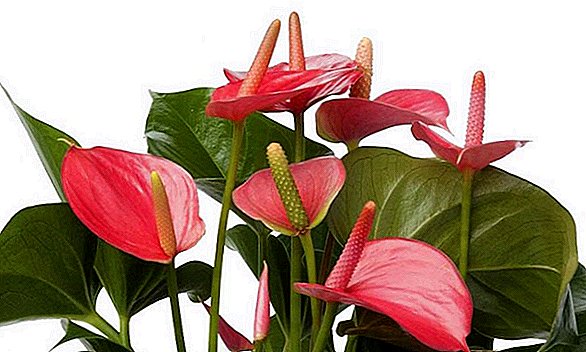
Did you know? The generic name "Anthurium" was derived from the Greek words anthos and oura. Literal translation - "blooming tail": a very appropriate name, given its inflorescence, consisting of a tall cone and bract.
Conditions for growing at home
At home, Anthurium Andre can be grown without difficulty, you only need to adhere to the plant's requirements for lighting, watering, fertilizing and temperature control. You also can not forget that the plant needs a period of rest with a low temperature.
Lighting
Being a tropical resident, Anthurium places strict demands on its location. The plant loves bright light, but does not tolerate direct sunlight. It can be grown on a windowsill, oriented to any side of the world, but in winter it will bloom only on the southern sill, on the north it will not bloom even in summer.  If there is no place for a flower anywhere except the north window, the problem can be solved by installing additional lighting. For illumination, you can use an ordinary fluorescent lamp or a special fitolamp.
If there is no place for a flower anywhere except the north window, the problem can be solved by installing additional lighting. For illumination, you can use an ordinary fluorescent lamp or a special fitolamp.
Find out which varieties of anthurium are popular with gardeners.
Temperature
Anthurium is not suitable for growing in the garden or on the terrace of the house, even in the warm summer months. It withstands a temperature drop of up to + 13 ° C and below only in the short term. The ideal room temperature for Andre Anthurium is from +18 to + 25 ° C.
Air humidity
Anthurium does not like dry air due to the operation of heating devices and drafts. Drying the leaves indicates that it is desirable to find a new place for the location of the flowerpot.
Also, the flower likes high humidity - for this reason it is necessary to spray its leaves more often with water from a spray bottle. If there is such an opportunity, it is necessary to use rain or melt water for this purpose. 
Home care
To stimulate the flowering of anthurium during the cold winter months, it is recommended:
- Moisturize the flower only when the topsoil is dry.
- Feeding moderately is enough feeding every 2 months.
- Plants should be provided with a rest period of 5-7 weeks at a temperature of about + 15 ° C.
Read more about the features of growing anthurium at home.
Watering
Anthurium does not like even a short period of drought. Properly chosen substrate for cultivation will pass moisture through itself well, preventing the waterlogging of the roots.
The flower in question is not advisable to be watered with tap hard water. Pre-tap water is boiled, then add a few drops of lemon to it to soften the hardness. After that, defend a closed container with water for two to three days and then use a liquid for irrigation. Water temperature for irrigation should be at room temperature so as not to cause temperature shock to the plant.  Irrigation can be done in several ways:
Irrigation can be done in several ways:
- water under the root;
- arrange wick irrigation;
- spray the greens with water from a spray bottle;
- pour water for irrigation in the pan.
Important! Using tap water for irrigation increases the pH value in the substrate. Since anthurium does not tolerate calcined soils, it is necessary to change the planting substrate annually. For the cultivation of anthurium should use peat soils.
Top dressing
The plant needs to be in the root zone of liquid fertilizer. Feeding is desirable to do in the period from April to September, regularly, with an interval of two weeks.
In winter, the frequency of nutrients is reduced - just feed the flower once every two months. Anthurium is fed with fertilizer for the orchid or bromeliad family. Top dressing can be purchased at flower shops.
As a natural fertilizer, sleeping coffee grounds or crushed eggshell are suitable. To apply them in a pot with a plant, carefully remove the top layer of soil (2-3 cm), then mix the natural fertilizer with this soil and return the substrate to its place.
Video: How and what to fertilize anthurium
Pruning
Dried flowers and anthurium leaves are cut close to the ground with a sharp knife or scissors. Other pruning is not required, as the plant does not produce side branches and is determinant, that is, having a certain point of growth. Well-groomed old bushes of anthurium become thick, lush and reach a maximum height of about 100 centimeters.
Transfer
With proper care and optimal growth conditions, the flower will sooner or later need a larger planting capacity. The signal to transplant is the appearance of roots on the soil surface. The transplant itself is not complicated and is performed within a few minutes. The ideal time for the procedure is early spring.  The plant is most suitable loose soil, permeable to moisture and air. These requirements correspond to the finished substrate for orchids, which can be purchased at flower shops. Before planting, the soil is mixed with a small amount of polystyrene foam balls. To prevent bogging, drainage is placed in a pot: fragments of clay or ceramic dishes, wooden twigs will be suitable as it.
The plant is most suitable loose soil, permeable to moisture and air. These requirements correspond to the finished substrate for orchids, which can be purchased at flower shops. Before planting, the soil is mixed with a small amount of polystyrene foam balls. To prevent bogging, drainage is placed in a pot: fragments of clay or ceramic dishes, wooden twigs will be suitable as it.
How to transplant anthurium:
- Gently tap the sides of the flowerpot from the bottom, while the earthen room with the root system is separated from the walls of the pot. If the compartment is insufficient, you need to carefully hold a sharp knife around the inner edge of the pot.
- To avoid damage, the plant should be held with one hand, while the other should tilt the pot down with a flower.
- A new large flower pot at this time should be already partially filled with prepared substrate.
- The root system is shielded from old soil residues whenever possible.
- Anthurium is set in the new pot in the center, after which the roots are completely covered with the substrate, slightly compacting the soil.
- The transplanted plant is watered moderately.
Important! If the plant stays too long in a pot of too small a volume, there may be an acute nutrient deficiency. Anthurium signals this with spotty, fading leaves and the withering away of flowers.
Breeding
Obtaining new anthurium plants requires some skills. There are several ways of reproduction: by splitting a bush, by cutting and sowing seeds.
Splitting a bush
The described plant is easy to propagate in this way. The procedure should be performed in the spring and preferably on older plants.  How to split a bush:
How to split a bush:
- Anthurium carefully removed from the flower pot.
- The root system is carefully divided into several parts by hand or with a sharp knife.
- On all separated parts must be equally present roots and greens.
- Separated plants are immediately planted in the soil.
Cuttings
A little more time and patience requires anthurium during reproduction by grafting.
How to propagate the plant cuttings:
- For this purpose, shoots are selected with small nodes, which are the primordia of future roots.
- The cuttings are cut with a very sharp knife at an angle of 45 °.
- Chopped stems are placed in a glass of water, which is placed in a well-lit place.
- For the formation of roots, the ideal temperature in the room is about + 20 ... + 25 ° C.
- It may take several weeks before the first thin roots appear. It is important to note that cuttings can be planted in the soil only after the formation of long and thick roots. Too short and weak cannot provide a young plant with enough water and nutrients.
Important! Anthurium contains toxins, so its leaves and flowers cannot be chewed, which small children and animals sometimes like to do, as this can lead to poisoning.
Growing from seed
If white, slightly translucent fruits are formed on a flower after flowering, you can grow anthurium from seeds. Since the period of seed germination is very limited, they should be sown as soon as possible after maturity of the fruit.  How to get new plants from seeds:
How to get new plants from seeds:
- The seeds are removed from the fruit, well washed in running water from the pulp and juice (juice inhibits germination).
- The seeds are allowed to dry slightly, after which they are immediately sown on the wetted and compacted surface of the peat substrate or sandy-peat soil.
- Small seeds do not fall asleep on top, as they need daylight for germination.
- The planting container with crops is covered with a transparent lid (glass or polyethylene), which is opened twice a day for half an hour for airing.
- The soil is constantly maintained in a slightly wet state, spraying with fine water spray spray.
- For seed germination in a room, it is necessary to maintain a temperature in the range of + 20 ... + 25 ° C.
- The first shoots will seem from the ground in about 10-12 days.
- As soon as two pairs of true leaves form on young seedlings, they dive, planting them in individual planting containers.
Possible difficulties in growing
The discoloration and wilting of the leaves can have various causes, which are not always associated with the infestation of a flower by pests or diseases. The same applies to leaf fall and weak or completely absent flower formation.  Possible errors in the care of anthurium:
Possible errors in the care of anthurium:
- Anthuriums do not like direct sunlight, but still need bright light. If the light is not enough, the plant does not bloom. Too high stems of rare leaves also indicate a lack of light. In this case, the location of the pot must be changed.
- Dry spots on the leaves indicate a lack of moisture. The flower should be watered more often, and the leaves of the plant should be sprayed with water containing a few drops of lemon juice.
- Twisting the leaves of anthurium indicates that the plant gets too much direct sunlight. In this case, it is also recommended to change the location of the flower.
- A yellowed border on the leaves indicates too cold air and excess moisture in the soil.
- Abundant and frequent feeding can lead to discoloration of the leaves. If the soil or substrate has a sufficient amount of its own nutrients, the time between feedings can be increased.
- Wilting of leaves and dying off of flowers - pH is too high in the soil. The plant needs an acid substrate. Carefully remove some of the old substrate from the pot and fill the empty space with fresh substrate with a high content of peat.
Did you know? The colored petal in the shape of a heart is not an anthurium flower, but a bract. His real flowers are made up of small cones, collected in the core, located in the center. The bract function is the protection of flowers.
Diseases
A tropical resident, like ordinary plants, is subject to the invasion of harmful insects and the development of diseases. Improper care also contributes to their appearance: if no urgent measures are taken, this can lead to the death of the plant.  Despite the fact that the flower likes to be in constant humidity, the anthurium can get sick if it is plentiful to be watered, but its roots are in a dense, impermeable substrate. Long-term roots in the water leads to the development of root rot, which is not amenable to treatment. As an ambulance, the plant can remove rotting and slimy roots, immediately transplant the flower in a suitable substrate, and then temporarily limit moisture. However, such measures do not always lead to success, and the infected root rot flower may die.
Despite the fact that the flower likes to be in constant humidity, the anthurium can get sick if it is plentiful to be watered, but its roots are in a dense, impermeable substrate. Long-term roots in the water leads to the development of root rot, which is not amenable to treatment. As an ambulance, the plant can remove rotting and slimy roots, immediately transplant the flower in a suitable substrate, and then temporarily limit moisture. However, such measures do not always lead to success, and the infected root rot flower may die.
Anthurium is also prone to fungal diseases:
- Anthracnose. It occurs after excessive watering and waterlogging of the soil. Causes black spots on the leaves.
- Septoria. The main symptom is randomly located spots with a brown dead core and yellow edges.
- Fusarium, rhizoctoniosis.
Did you know? The unique heart-shaped shape and long-term nature of flowering make Anthurium a real home decoration. There are hybrids with gorgeous colors of the bracts: chocolate, burgundy, black, green, pink, white and red.
Pests
The flower is attacked by insect pests that feed on its cells and juice:
- Aphids suck the juice of anthurium and can serve as a source of infection with fungal diseases. The small size and masking coloring of the pests allows them to go unnoticed for a long time. Their presence is indicated by discoloration and damage to leaves and flowers - in this case, measures must be taken immediately. To prevent the further spread of insects, an infected plant is first quarantined. To destroy parasites, it is necessary to apply chemical poison in the form of granules and sprayed liquids.
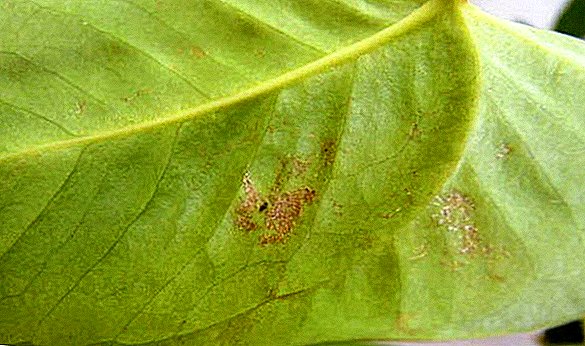
- The color of the leaves - from gray-green to copper-brown or green with yellow, indicates an attack by a spider mite. A closer look at the leaves reveals a thin web that covers the diseased areas of the anthurium. The parasite itself cannot be seen without a microscope - the average size of the spider mite is 0.6 mm. To clean the plant from the tick, you can use a chemical spray treatment of the bush or using special insecticides that are added to the water for irrigation. Wiping the affected leaves with a soapy sponge on both sides also helps to fight the spider mite, but this method is not very effective if there is a large pest population on the plant.
Anthurium is a very beautiful plant that adorns any room with its greenery and bright unusual bracts. It is easy to care for him when growing at home. If the requirements for location, room temperature and irrigation are met, the anthurium will delight the grower for almost all year round with its decorative bracts, colloquially called flowers.










